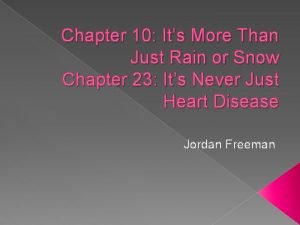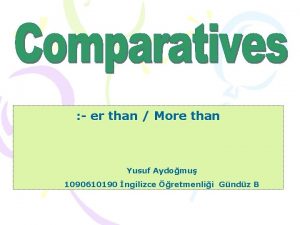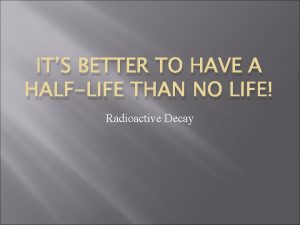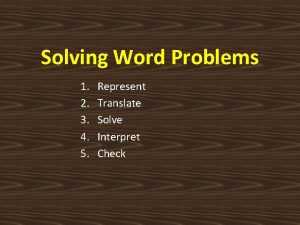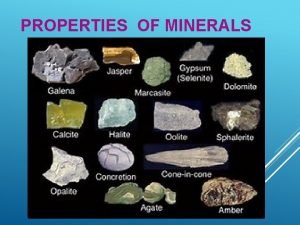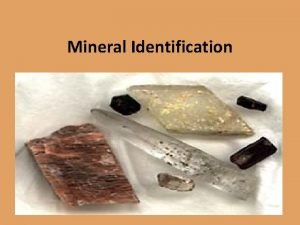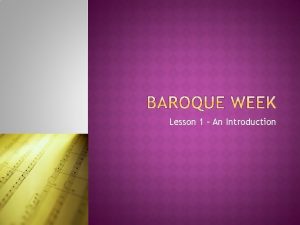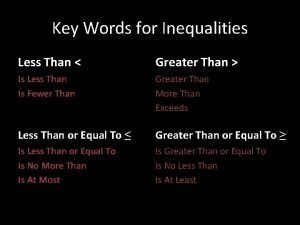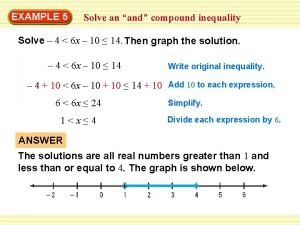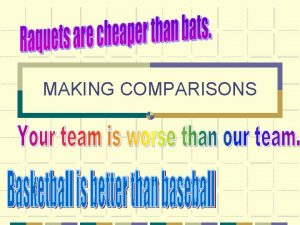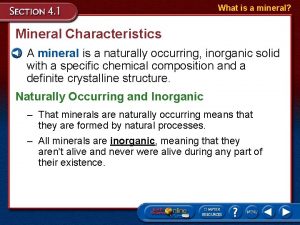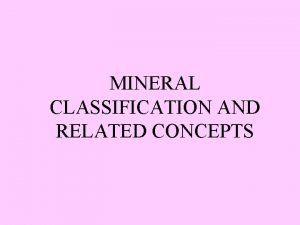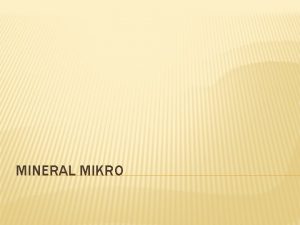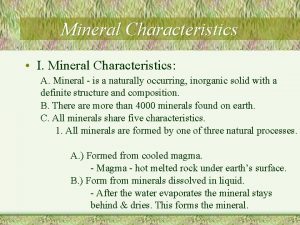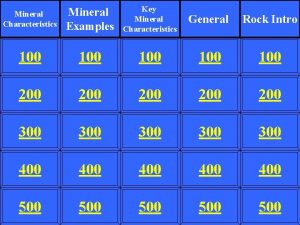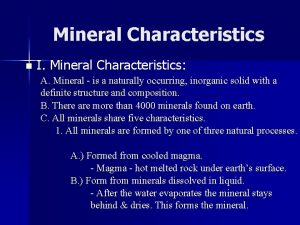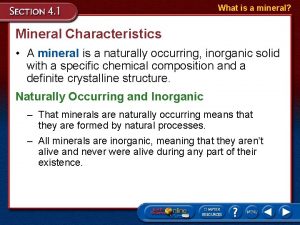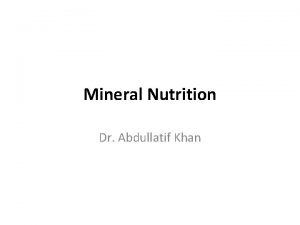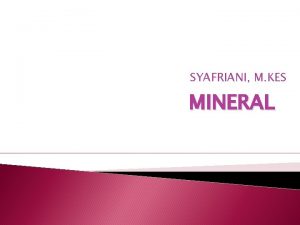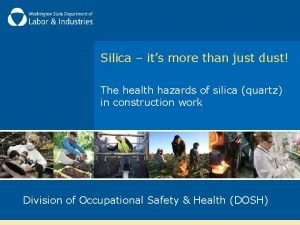What is a Mineral Its more than just


























- Slides: 26

What is a Mineral? It’s more than just a pretty stone! 9/24/2020 1

§ https: //www. youtube. com/watch? v=8 a 7 p 1 NFn 64 s 9/24/2020 2

11. 1 How Do Geological Processes Relate to Society and the Environment? § Mineral resources are produced by geological processes active at the surface and within Earth. § Earth’s rock cycle takes millions of years to produce mineral resources, making minerals a nonrenewable resource.

What Are Minerals? § Naturally occurring, chemical elements or inorganic compounds (solids) with regularly arranged atoms or ions § Mineral resource: one or more minerals that can be extracted, processed, and used in manufacturing § Some contain only one element (gold, lanthanum, salt), others contain more than one element as in an inorganic compound (quartz and rare earth oxides)

CONCEPT REVIEW § EARTH IS MOSTLY MADE UP OF ROCK § ROCKS ARE MADE UP OF MINERALS § THERE ARE 3800+ NAMED MINERALS § MOST ROCKS ARE MADE OF JUST A FEW OF THESE

What Are Rocks? § Rocks: solid collections of one or more minerals in Earth’s crust § Sedimentary rocks (sandstones, shale) § Sediments compacted and cemented into rock § Igneous rocks (granite, lava rock) § Cooled magma and lava § Metamorphic rocks (slate, marble) § Exposed and altered by high pressures and temperatures

Recycling of Earth’s Rocks § Rock cycle: the interaction of physical and chemical processes that work to change rocks from one kind to another § Recycling processes: erosion, melting, metamorphism § The rock cycle can take millions of years, so these resources are considered nonrenewable.

The Rock Cycle

Characteristics of Minerals § In order to be classified as a mineral, a substance MUST: § Be naturally occurring § Be inorganic (generally) § Be a solid § Have a definite chemical composition § Have a repeating crystal lattice 9/24/2020 9

Naturally Occurring § Mineral must be found in nature § Not artificially created in the lab § For example – cubic zirconium is NOT a mineral since it is artificial only § However, halite created in the lab IS a mineral because it is also found in nature 9/24/2020 10

Generally Inorganic § Inorganic substances are non-living (past, present, future) § Mineral can not be formed from living things § Exception – calcite is produced by living sea creatures 9/24/2020 11

Generally Inorganic § Inorganic substances are NOT carbon-based § However, a mineral CAN contain carbon (calcite – Ca. CO 3) § Other exceptions are Graphite (C) and Diamond (C) 9/24/2020 12

Solid § Minerals cannot be liquids or gases § For example – water is NOT a mineral, but glacial ice IS a mineral 9/24/2020 13

Repeating Crystal Lattice § A lattice is a repeating structural pattern § For example – quartz ALWAYS has one silicon atom bonded to four oxygen atoms § Chemistry note – strong bonds are why minerals are solids! 9/24/2020 14

Definite Chemical Formula (Composition) § A mineral must have a definite chemical composition that identifies it as unique. § For example – halite is Na. Cl § Some minerals do have minor variations in their formulas §For example – Feldspar can be made from potassium, calcium, or magnesium 9/24/2020 15

Definite Chemical Formula § Minerals are expressed by a specific chemical formula -Gold (Au) -Calcite (Ca. CO 3) -Quartz (Si. O 2) -Pyrite (Fe. S 2) -Halite (Na. Cl)

Definite Chemical Composition 9/24/2020 17

Repeating Crystal Lattice § Minerals with the same chemical composition can have different lattices – making them different minerals! § For example – take a look at these lattices for Diamond (C) and Graphite (C). 9/24/2020 18

How are minerals formed? § Minerals are formed by five basic processes § Cooling of magma § Precipitation (not rain!) § Metamorphism § Chemical Weathering § Hydrothermal Solutions § Type of mineral formed is based on process 9/24/2020 19

Cooling of Magma § Magma is a molten “soup” of minerals § As it cools, certain minerals crystallize at different temperatures § This removes some elements from the magma and changes its composition 9/24/2020 20

Precipitation § Precipitation here refers to the formation of a solid from a liquid § Can be as simple as evaporation or a chemical reaction where two liquids combine to form a solid § Calcite, gypsum, and halite form this way. 9/24/2020 21

Metamorphism § Metamorphism is a change in a mineral (or rock) brought about by changes in heat and pressure. § Increased heat and/or pressure causes mineral structure (lattices) to change – resulting in a new mineral § Minerals can be recrystallized or foliated (aligned in layers) § Examples include talc, kyanite, garnet, and sillimanite 9/24/2020 22

Metamorphism 9/24/2020 23

Chemical Weathering § Chemical weathering of minerals occurs at the surface of the earth in soils and clays § Chemical reactions take place and change the mineral structures – resulting in a new mineral § For example – orthoclase reacts with acid rain to form kaolinite 9/24/2020 24

Hydrothermal Solutions § A hydrothermal solution is a hot water solution containing a variety of substances § The temperature of the water allows a great deal of mixing and reacting to take place § Results in numerous combinations of substances – forming many minerals § Sulfides are often formed this way 9/24/2020 25

Summary § A mineral is a naturally occurring solid with a definite chemical formula and crystal lattice and is generally inorganic. § Minerals can form in five common ways – magma cooling, precipitation, metamorphism, chemical weathering, and hydrothermal solutions. 9/24/2020 26
 Lirik lagu more more more we praise you
Lirik lagu more more more we praise you More more more i want more more more more we praise you
More more more i want more more more more we praise you Thousands of possibilities get yours slogan
Thousands of possibilities get yours slogan Not just bingo march
Not just bingo march Math is more than just numbers
Math is more than just numbers It's more than just rain or snow
It's more than just rain or snow Software is more than just
Software is more than just Er than more than
Er than more than 5730x5
5730x5 Greater than god more evil than the devil
Greater than god more evil than the devil An angle is 57 more than twice its complement
An angle is 57 more than twice its complement Society is more than the sum of its parts
Society is more than the sum of its parts Properties of mineral
Properties of mineral Directions of cleavage
Directions of cleavage Does juliet wake up just before romeo dies or just after?
Does juliet wake up just before romeo dies or just after? A grosso has a group of soloists rather
A grosso has a group of soloists rather Its not just anymore
Its not just anymore Fractions greater less than or equal to
Fractions greater less than or equal to Dot
Dot Less than keywords
Less than keywords Compound inequality examples
Compound inequality examples Greater than less than fractions
Greater than less than fractions Percents less than 1
Percents less than 1 Jesus lord of heaven
Jesus lord of heaven Turing machine is more powerful than: *
Turing machine is more powerful than: * Define curriculum
Define curriculum What are jovian planets made of
What are jovian planets made of





